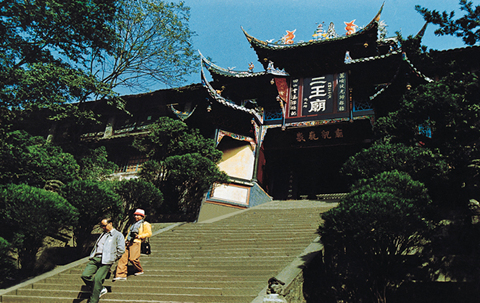在2008年汶川大地震中损毁的都江堰文物的修缮工作正在紧张进行,并将于今年9月竣工。修缮工作由全国多省的文物保护专业工作团队共同完成。至目前为止,中央政府共投资9500万元。

都江堰市位于成都西北,距震中映秀仅17.5公里,至今已有2000多年的历史,以建于秦代的都江堰和坐落在岷江东岸的二王庙、伏龙观等文化遗址闻名于世。在2008年5月12日发生的汶川地震中,二王庙景区的多座古建筑损毁严重。
专家学者在地震发生的第二天就到现场勘测灾情,2008年5月18日提交了检查报告,重建二王庙景区文物建筑工作于2008年6月正式开始。北京清华城市设计规划院文化遗产保护研究所进行施工设计,广西、福建两省的文物保护局负责进行文物本体的施工,辽宁有色基础工程公司负责地质灾害治理。共约400名工人参加了修建工作。
据都江堰市文物局局长樊拓宇介绍,修护工作主要包括两个部分。第一部分是地质灾害治理,使古建筑免于地震、洪水等自然灾害的再次破坏。第二部分是文物本体修复。目前为止伏龙观已经修复完毕,二王庙的修缮工作已完成一半。
地质灾害治理工作包括两个部分。首先,加固古建筑的地基,使之在洪水和地震同时发生的情况下不至于滑落到江中。工人们在不稳固的黄土平台下打了72根17米到23米的混凝土大桩,连成一个稳固的整体。其次,恢复传统的木结构。“我们纠正了以前修缮的时候留下的一些问题,比如用砖结构代替木结构。中国古代的木结构本身就具有非常好的抗震性,我们这次按照以前的样式修缮。”樊局长说道。
文物本体修缮工作将会恢复原来的设计。工人选用一种从当地漆树中提炼的生物漆进行建筑表面的粉刷,而不用化学成分的油漆。虽然成本更高,耗时更久,但生物漆可以更好地保持建筑表面的颜色和光泽。所有的木头也被重新烘干,并浸泡在防腐防虫的液体中,以应对当地的潮湿气候。
在施工的过程中,工作人员遇到了无数困难。比如,设计稿无法在短时间内拿出,很多时候专家和工人不得不在施工现场讨论某个部分该如何修建。另外,虽然有古代的设计图纸,但是许多细节仍然缺失。中国摄影家协会提供了若干摄影家拍摄的当地照片作为参考,为恢复都江堰的古建筑提供了重要依据。“我们能用原来的材料,就用原来的。我周围的亲戚朋友都说,让二王庙恢复原样是一件大好事。”樊局长笑着说。
Quake-damaged heritage buildings in Dujiangyan being restored
After being damaged by Sichuan earthquake in 2008, cultural heritage buildings in Dujiangyan City are being restored and will be finished in September this year. The reconstruction work is being carried out by scholars and professional workers from all over China. The central government has invested 95 million yuan to date.
Dujiangyan City is located to the northwest of Chengdu and 17.5 miles from Yingxiu, the epicenter of the earthquake happened on May 12, 2008. It has about 2,000 years of history and is known to the world for Dujiangyan dam, built in Qin Dynasty and Erwang Temple and Fulong Temple , which are located on the east side of Minjiang River and fell apart in the massive quake.
Scholars went to inspect the damage on the second day of the earthquake. They provided a report on May 18 and the restoration project began in June, 2008. About 400 workers from the cultural heritage protection bureaus of Guangxi and Fujian Provinces participated in the reconstruction. Liaoning Non-Ferrous Foundation Engineering Corporation is in charge of building foundation of the temples. The designers are from Cultural Heritage Protection Research Center of Beijing Tsinghua Urban Planning and Design Institute.
According to Fan Tuoyu, head of Dujiangyan Cultural Heritage Bureau, the project includes two phases. The first phase is strengthening foundation of heritage buildings to protect them from natural disasters such as earthquake and flood. The second phase is repairing the falling buildings. The restoration of Fulong Temple has been completed and 50 percent of the repair work of Erwang Temple has been finished.
The strengthening phase includes two parts. The first one is to lay a solid foundation below the temples to prevent them from sliding into the river if massive earthquake and flood happen at the same time. Workers build 72 of concrete pillars from 17m to 23m to sustain the unstable platform where Erwang Temple and other buildings sit. The second part is to restore the temples in traditional way. "We will correct some mistaken design made in the past few years and use traditional Chinese wooden structure. The traditional design can protect the buildings from earthquake very well." Fan said to China.org.cn.
The repairing phase will also be done in accordance with its original design. The workers choose to use a type of biological paint collected from local trees instead of the chemical one. Though it will cost more time and money, it can keep the color and luster of buildings for a longer time. All the wood used in the temples has been dried and soaked in antiseptic to protect it from the humid weather in Dujiangyan.
Countless difficulties occurred during the process. For example, the new design could not come out in a short time. So workers and scholars often discussed how to restore a certain part of the temples without design. The lack of detailed historical reference is another problem. China Photographers Association contributed hundreds of photos of Erwang Temple. "We used the original materials as many as possible." Fan smiled. "Relatives and friends of mine think we have done a good deed to restore the temples."
(China.org.cn translated by Ren Zhongxi January 28, 2010)
 English
English Japanese
Japanese Korean
Korean French
French German
German Spanish
Spanish Italian
Italian Arab
Arab Portuguese
Portuguese Vietnamese
Vietnamese Russian
Russian Finnish
Finnish Thai
Thai dk
dk